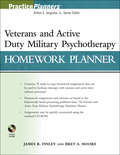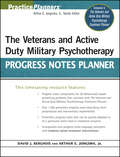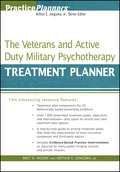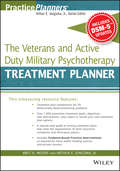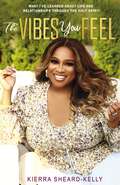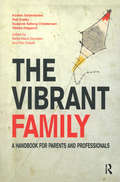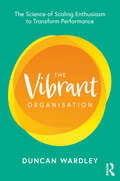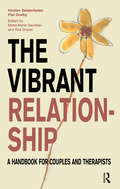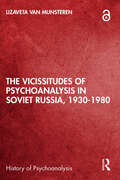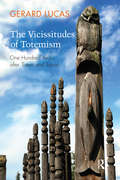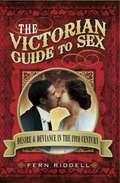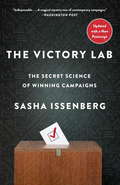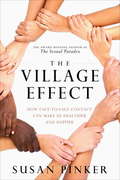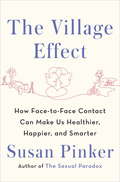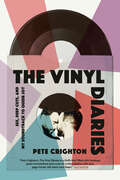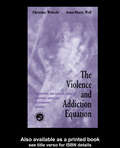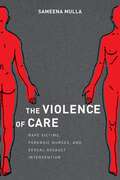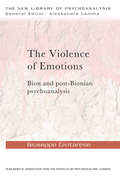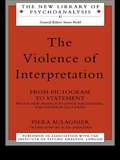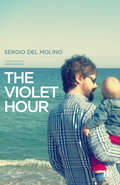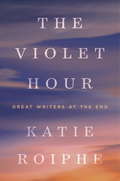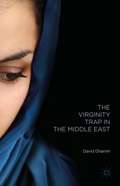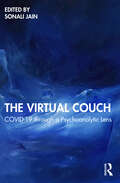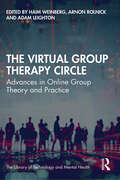- Table View
- List View
The Veterans and Active Duty Military Psychotherapy Homework Planner
by Bret A. Moore James R. FinleyFeatures assignments and exercises to meet the changing needsof mental health professionals The Veterans and Active Duty Military Psychotherapy Homework Planner provides you with an array of ready-to-use, between-session assignments designed to fit virtually every therapeutic mode. This easy-to-use sourcebook features: 78 ready-to-copy exercises covering the most common issues encountered by veterans and active duty soldiers in therapy, such as anger management, substance abuse and dependence, bereavement, pre-deployment stress, and chronic pain after injury A quick-reference format-the interactive assignments are grouped by behavioral problems including combat and operational stress reactions, postdeployment reintegration, survivor's guilt, anxiety, parenting problems related to deployment, and posttraumatic stress disorder Expert guidance on how and when to make the most efficient use of the exercises Assignments are cross-referenced to The Veterans and Active Duty Military Psychotherapy Treatment Planner-so you can quickly identify the right exercise for a given situation or problem A CD-ROM that contains all the exercises in a word-processing format-allowing you to customize them to suit you and your clients' unique styles and needs
The Veterans and Active Duty Military Psychotherapy Progress Notes Planner
by David J. Berghuis Arthur E. JongsmaThe Veterans and Active Duty Military Psychotherapy Progress Notes Planner contains complete prewritten session and patient presentation descriptions for each behavioral problem in The Veterans and Active Duty Military Psychotherapy Treatment Planner. The prewritten progress notes can be easily and quickly adapted to fit a particular client need or treatment situation. Saves you hours of time-consuming paperwork, yet offers the freedom to develop customized progress notes Organized around 39 behaviorally based presenting problems, including nightmares, post- deployment reintegration, combat and operational stress reaction, amputation and/or loss of mobility, adjustment to killing, and depression Features over 1,000 prewritten progress notes (summarizing patient presentation, themes of session, and treatment delivered) Provides an array of treatment approaches that correspond with the behavioral problems and DSM-IV-TR diagnostic categories in The Veterans and Active Duty Military Psychotherapy Treatment Planner Offers sample progress notes that conform to the requirements of most third-party payors and accrediting agencies, including CARF, The Joint Commission (TJC), COA, and the NCQA Presents new and updated information on the role of evidence-based practice in progress notes writing and the special status of progress notes under HIPAA
The Veterans and Active Duty Military Psychotherapy Treatment Planner
by Arthur E. Jongsma Jr. Bret A. MooreThe Veterans and Active Duty Military Psychotherapy Treatment Planner provides all the elements necessary to quickly and easily develop formal treatment plans that satisfy the demands of HMOs, managed care companies, third-party payors, and state and federal agencies. Features empirically supported, evidence-based treatment interventions Organized around 39 main presenting problems in treating veterans and active duty military personnel, including substance abuse, adjustment to killing, anger management and domestic violence, pre-deployment stress, survivors' guilt, and combat and operational stress reaction Over 1,000 prewritten treatment goals, objectives, and interventions-plus space to record your own treatment plan options Easy-to-use reference format helps locate treatment plan components by behavioral problem Designed to correspond with The Veterans and Active Duty Military Psychotherapy Progress Notes Planner Includes a sample treatment plan that conforms to the requirements of most third-party payors and accrediting agencies including CARF, The Joint Commission (TJC), COA, and the NCQA
The Veterans and Active Duty Military Psychotherapy Treatment Planner, with DSM-5 Updates (PracticePlanners)
by Arthur E. Jongsma Jr. Bret A. MooreThis timesaving resource features: Treatment plan components for 39 behaviorally based presenting problems Over 1,000 prewritten treatment goals, objectives, and interventions—plus space to record your own treatment plan options A step-by-step guide to writing treatment plans that meet the requirements of most insurance companies and third-party payors Includes Evidence-Based Practice Interventions as required by many public funding sources and private insurers PracticePlanners® THE BESTSELLING TREATMENT PLANNING SYSTEM FOR MENTAL HEALTH PROFESSIONALS The Veterans and Active Duty Military Psychotherapy Treatment Planner provides all the elements necessary to quickly and easily develop formal treatment plans that satisfy the demands of HMOs, managed care companies, third-party payors, and state and federal agencies. Features empirically supported, evidence-based treatment interventions Organized around 39 main presenting problems in treating veterans and active duty military personnel, including substance abuse, adjustment to killing, anger management and domestic violence, pre-deployment stress, survivors' guilt, and combat and operational stress reaction Over 1,000 prewritten treatment goals, objectives, and interventions—plus space to record your own treatment plan options Easy-to-use reference format helps locate treatment plan components by behavioral problem Designed to correspond with The Veterans and Active Duty Military Psychotherapy Progress Notes Planner Includes a sample treatment plan that conforms to the requirements of most third-party payors and accrediting agencies including CARF, The Joint Commission (TJC), COA, and the NCQA Additional resources in the PracticePlanners® series: Progress Notes Planners contain complete, prewritten progress notes for each presenting problem in the companion Treatment Planners. Homework Planners feature behaviorally based, ready-to-use assignments to speed treatment and keep clients engaged between sessions. For more information on our PracticePlanners®, including our full line of Treatment Planners, visit us on the Web at: www.wiley.com/practiceplanners
The Vibes You Feel: What I’ve Learned about Life and Relationships through the Holy Spirit
by Kierra Sheard-KellyThis inspiring book for teens and young women explores what it means to listen to God&’s voice, better understand the &“vibes&” and intuition the Spirit uses as guidance, and live a life that proclaims your heavenly truth. Filled with personal lessons from author and Grammy-nominated artist Kierra &“Kiki&” Sheard-Kelly and empowering scriptural promises, you&’ll grow stronger in your faith as well as your God-given purpose.Each day, we are under attack—by people who want to keep us down or who doubt our gifts, as well as by spiritual forces who want to knock us off our God-given path and into the darkness. In The Vibes You Feel, Kierra &“Kiki&” Sheard-Kelly invites you to uncover what it means to have the Holy Spirit in your life, and how listening to the vibes we sense in certain situations can help steer us toward the future God intends. Inside The Vibes You Feel, you&’ll find:encouragement and support for navigating today&’s worldsolid biblical truths and scriptural promises that arm you for the tough decisions and battles in your lifeKierra&’s own personal stories and experiences with difficult situations, and the spiritual nudges that helped her throughAdvice and guidance with actionable steps In addition, The Vibes You Feel:is an ideal gift for birthdays, Christmas, Easter, or graduationshelps you grow closer to God and understand the signals he sendsis perfect for those looking for motivation and biblical guidance Also check out Kierra Sheard-Kelly&’s bestselling and inspirational book, Big, Bold, and Beautiful.
The Vibrant Family: A Handbook for Parents and Professionals (The Systemic Thinking and Practice Series)
by Susanne Soborg ChristensenThe Vibrant Family offers completely new and surprising approaches to parenthood. This book is not about child rearing, setting limits, or a specific way of communicating with children. It is about the ways in which well-being in our relationship is crucial to a good family life with confident and balanced children. The clear message of the book is that it is not the children who should change in order to get the family to function it is the parents. The book also offers practical and concrete tools to help you understand how you and your partner can learn to communicate and act in an accepting and close way, creating a climate in the family that encourages joy and growth.
The Vibrant Organisation: The Science of Scaling Enthusiasm to Transform Performance
by Duncan WardleyThe Vibrant Organisation translates the science of human behaviour into a playbook of highly practical interventions that build and scale enthusiasm, transforming organisational culture and performance. The book helps create more joy and fulfilment at work, whilst also steering a path to sustained competitive advantage. Using cutting-edge research in neuroscience and psychology, as well as the author’s considerable practical experience, Duncan Wardley offers a three-part framework for building teams of agile, adaptable, curious, and highly motivated people: Reset shows how to reduce the threat response by creating a safe environment for employees Ignite teaches leaders how to create events or experiences that create flashes of insight and motivation Fuel demonstrates how to sustain people’s motivation through repeatable actions, resulting in an upward spiral of enthusiasm. Packed with fascinating research, on-the-ground stories, and new scientific findings – along with practical tools and exercises – The Vibrant Organisation is a must read for business leaders at all levels looking to get the best out of themselves and their people.
The Vibrant Relationship: A Handbook for Couples and Therapists (The Systemic Thinking and Practice Series)
by Kirsten Seidenfaden Piet DraibyThe book is divided into easy to grasp sections of theory and practical exercises. In the first part of the book, two of Denmark's most experienced practitioners in couples' therapy, psychologist Kirsten Seidenfaden and psychiatrist Piet Drailby, explain why we tend to get confused about love. In the exercise section of the book, they provide some simple, yet very efficient, tools to help us find out where we lost our way and how we can remain in a loving vibrant relationship for the rest of our lives.
The Vicarious Brain, Creator of Worlds
by Alain BerthozGroping around a familiar room in the dark, relearning to read after a brain injury, navigating a virtual landscape through an avatar: all are expressions of vicariance—when the brain substitutes one process or function for another. Alain Berthoz shows that this capacity allows humans to think creatively in an increasingly complex world.
The Vicissitudes of Psychoanalysis in Soviet Russia, 1930-1980 (The History of Psychoanalysis Series)
by Lizaveta van MunsterenThis book considers the changing fortunes of psychoanalysis in Soviet Russia from 1930 to 1980.Approaching social history in a psychoanalytic key, Lizaveta van Munsteren argues that the growing split between official and informal languages of the time produced multiple strategies to keep alive the conversation around prohibited subjects. Through original archival research on figures such as Bluma Zeigarnik, Alexander Luria, Filipp Bassin and Dmitry Uznadze, van Munsteren offers a more nuanced understanding of Soviet studies of the unconscious and the role of language in the formation of the mind and in mental disturbances. This book makes a significant contribution to the historiography of psychoanalysis and to the study of the cultural influence of psychoanalysis and its interdisciplinary engagements.The Vicissitudes of Psychoanalysis in Soviet Russia, 1930-1980 will appeal to historians of psychoanalysis and psychology in Soviet Russia, psychosocial researchers and anyone interested in the critical history of psychoanalysis.
The Vicissitudes of Totemism: One Hundred Years After Totem and Taboo
by Gerard LucasAfter being the subject of many studies up until 1914, totemism seemed to disappear from the literature. The publication of Freud's work Totem and Taboo was initially greeted with silence, and subsequently with critical and hostile reactions. C. Levi-Strauss was one of the few to devote a book to totemism but considered it as an illusion, although a number of prominent members of the English school of Social Anthropology contested this view, describing the direction adumbrated by Freud's enquiry as "highly pertinent". Totemism appears in Freud's work as a way of dealing with one of the canonical forms of human destructiveness, namely parricide. Why did eminent men find it impossible to utilise Freud's book and those studies that followed it in the interwar period? The mass murders in Nazi Germany and Stalinist Russia, however different they may have been, both generated a profound sense of horror that made their consequences largely unrepresentable for Europeans for more than thirty years.
The Victorian Guide to Sex: Desire & Deviance in the 19th Century
by Fern Riddell“An enjoyable read and an informative survey of Victorian sexual tastes and preoccupations . . . a rigorously balanced account of this complex subject.” —Victorian SecretsAn exciting factual romp through sexual desire, practices and deviance in the Victorian era. The Victorian Guide to Sex will reveal advice and ideas on sexuality from the late 19th century. Drawing on both satirical and real-life events from the period, it explores every facet of sexuality that the Victorians encountered.Reproducing original advertisements and letters, with extracts taken from memoirs, legal cases, newspaper advice columns, and collections held in the Museum of London and the British Museum, this book reveals historical sexual proclivities.“Riddell’s book lifts the veil on historic sexual attitudes to illuminate the secrets of our ancestors’ lives. Written with wry humour in a pastiche of Victorian style, the book is both entertaining and highly informative.” —Your Family Tree
The Victory Lab: The Secret Science of Winning Campaigns
by Sasha IssenbergUPDATED FOR THE 2016 ELECTIONThe book Politico calls "Moneyball for politics" shows how cutting-edge social science and analytics are reshaping the modern political campaign.Renegade thinkers are crashing the gates of a venerable American institution, shoving aside its so-called wise men and replacing them with a radical new data-driven order. We've seen it in sports, and now in The Victory Lab, journalist Sasha Issenberg tells the hidden story of the analytical revolution upending the way political campaigns are run in the 21st century. The Victory Lab follows the academics and maverick operatives rocking the war room and re-engineering a high-stakes industry previously run on little more than gut instinct and outdated assumptions. Armed with research from behavioural psychology and randomized experiments that treat voters as unwitting guinea pigs, the smartest campaigns now believe they know who you will vote for even before you do. Issenberg tracks these fascinating techniques--which include cutting edge persuasion experiments, innovative ways to mobilize voters, heavily researched electioneering methods--and shows how our most important figures, such as Barack Obama and Mitt Romney, are putting them to use with surprising skill and alacrity. Provocative, clear-eyed and energetically reported, The Victory Lab offers iconoclastic insights into political marketing, human decision-making, and the increasing power of analytics.
The Village Effect
by Susan PinkerIn her surprising, entertaining and persuasive new book, award-winning author and psychologist Susan Pinker shows how face-to-face contact is crucial for learning, happiness, resilience and longevity. From birth to death, human beings are hard-wired to connect to other human beings. Face to face contact matters: tight bonds of friendship and love heal us, help children learn, extend our lives and make us happy. Looser in-person bonds matter, too, combining with our close relationships to form a personal "village" around us, one that exerts unique effects. And not just any social networks will do: we need the real, face-to-face, in-the-flesh encounters that tie human families, groups of friends and communities together. Marrying the findings of the new field of social neuroscience together with gripping human stories, Susan Pinker explores the impact of face-to-face contact from cradle to grave, from city to Sardinian mountain village, from classroom to workplace, from love to marriage to divorce. Her results are enlightening and enlivening, and they challenge our assumptions. Most of us have left the literal village behind, and don't want to give up our new technologies to go back there. But, as Pinker writes so compellingly, we need close social bonds and uninterrupted face-time with our friends and families in order to thrive--even to survive. Creating our own "village effect" can make us happier. It can also save our lives.From the Hardcover edition.
The Village Effect
by Susan PinkerIn her surprising, entertaining, and persuasive new book, award-winning author and psychologist Susan Pinker shows how face-to-face contact is crucial for learning, happiness, resilience, and longevity. From birth to death, human beings are hardwired to connect to other human beings. Face-to-face contact matters: tight bonds of friendship and love heal us, help children learn, extend our lives, and make us happy. Looser in-person bonds matter, too, combining with our close relationships to form a personal "village" around us, one that exerts unique effects. Not just any social networks will do: we need the real, in-the-flesh encounters that tie human families, groups of friends, and communities together. Marrying the findings of the new field of social neuroscience with gripping human stories, Susan Pinker explores the impact of face-to-face contact from cradle to grave, from city to Sardinian mountain village, from classroom to workplace, from love to marriage to divorce. Her results are enlightening and enlivening, and they challenge many of our assumptions. Most of us have left the literal village behind and don't want to give up our new technologies to go back there. But, as Pinker writes so compellingly, we need close social bonds and uninterrupted face-time with our friends and families in order to thrive--even to survive. Creating our own "village effect" makes us happier. It can also save our lives.Advance praise for The Village Effect "A terrific book . . . Pinker makes a hardheaded case for a softhearted virtue. Read this book. Then talk about it--in person!--with a friend."--Daniel H. Pink, New York Times bestselling author of Drive and To Sell Is Human "What do Sardinian men, Trader Joe's employees, and nuns have in common? Real social networks--though not the kind you'll find on Facebook or Twitter. Susan Pinker's delightful book shows why face-to-face interaction at home, school, and work makes us healthier, smarter, and more successful."--Charles Duhigg, New York Times bestselling author of The Power of Habit: Why We Do What We Do in Life and Business "Provocative and engaging . . . Pinker is a great storyteller and a thoughtful scholar. This is an important book, one that will shape how we think about the increasingly virtual world we all live in."--Paul Bloom, author of Just Babies: The Origins of Good and Evil "A fascinating, nuanced study of that most fundamental need: the need for human connection."--Maria Konnikova, New York Times bestselling author of Mastermind: How to Think Like Sherlock Holmes "The Village Effect is a fascinating explanation of why we need regular contact with people, not just screens--and why time spent with your neighbors will enrich and extend your life in ways you never imagined."--John Tierney, New York Times bestselling co-author of Willpower: Rediscovering the Greatest Human Strength "With a raft of surprising data, this compulsively readable, lively and meticulously researched book shows that direct and frequent human contact is at least as important to our survival as clean air or good nutrition."--Christina Hoff Sommers, author of Freedom Feminism: Its Surprising History and Why It Matters TodayFrom the Hardcover edition.
The Vinyl Diaries: Sex, Deep Cuts, and My Soundtrack to Queer Joy
by Pete CrightonA poignant, funny, and lively memoir of sexual awakening, music, and discovering one's true self. Pete Crighton came of age in the early/mid 1980s in the shadow of HIV/AIDS. Growing up in Toronto, he was terrified that his friends and schoolmates would find out that he was &“different&” at a time when being gay felt like a death sentence. His only comfort was music, the songs a balm to his painful adolescence. Struggling to make sense of his sexuality and fear of the disease stifled Crighton as a sexual being. Instead of exploring sex, he began curating a massive music library. He then took what he thought was a safe path and entered into two long-term monogamous relationships, both doomed to fail. Finally, in his 40s, Crighton decided to ignore his fear and live his queer life to the fullest.The Vinyl Diaries is the story of Crighton&’s mid-life sexual awakening. From one-night trysts to friendships resulting from app-based hookups, Crighton is honest and unapologetic as he chronicles the pursuit of his erotic desires. Each new connection and lover is linked to an artist, song, or album from his vast collection and backdrops the stories Crighton tells about his life, interconnected with the artists' work and histories. Kate Bush, the B-52s, Prince, The Smiths, Yoko Ono, and Stevie Nicks are just a few of the artists who provide an extraordinary soundtrack to Crighton&’s adventures.Big-hearted, funny, thoughtful, and wildly entertaining, The Vinyl Diaries is a celebration of sex, music and the discovery of our true selves.
The Violence and Addiction Equation: Theoretical and Clinical Issues in Substance Abuse and Relationship Violence
by Christine Wekerle Anne-Marie WallThe Violence and Addiction Equation is an empirically based book that bridges the relationship between violence and substance addiction with a focus on the overlap of issues. It is a groundbreaking collection of contributions by prominent clinicians in the field, and the timely chapter's include clinical commentary that identifies and elaborates on points of transfer from theory to clinical practice.
The Violence of Care: Rape Victims, Forensic Nurses, and Sexual Assault Intervention
by Sameena MullaWinner, 2017 Margaret Mead Award presented by the American Anthropological Association and the Society for Applied AnthropologyHonorable Mention, 2015 Eileen Basker Memorial Prize presented by the Society for Medical Anthropology Analyzes the ways in which nurses work to collect and preserve evidence while addressing the needs of sexual assault victims as patientsEvery year in the US, thousands of women and hundreds of men participate in sexual assault forensic examinations. Drawing on four years of participatory research in a Baltimore emergency room, Sameena Mulla reveals the realities of sexual assault response in the forensic age. Taking an approach developed at the intersection of medical and legal anthropology, she analyzes the ways in which nurses work to collect and preserve evidence while addressing the needs of sexual assault victims as patients.Mulla argues that blending the work of care and forensic investigation into a single intervention shapes how victims of violence understand their own suffering, recovery, and access to justice—in short, what it means to be a “victim”. As nurses race the clock to preserve biological evidence, institutional practices, technologies, and even state requirements for documentation undermine the way in which they are able to offer psychological and physical care. Yet most of the evidence they collect never reaches the courtroom and does little to increase the number of guilty verdicts. Mulla illustrates the violence of care with painstaking detail, illuminating why victims continue to experience what many call “secondary rape” during forensic intervention, even as forensic nursing is increasingly professionalized. Revictimization can occur even at the hands of conscientious nurses, simply because they are governed by institutional requirements that shape their practices.The Violence of Care challenges the uncritical adoption of forensic practice in sexual assault intervention and post-rape care, showing how forensic intervention profoundly impacts the experiences of violence, justice, healing and recovery for victims of rape and sexual assault.
The Violence of Emotions: Bion and Post-Bionian Psychoanalysis (The New Library of Psychoanalysis)
by Giuseppe CivitareseIn The Violence of Emotions the author marries an ability to introduce the reader to the intimate climate of an analytic session with a passionate rereading of Bion. To emphasize both the empirical nature of psychoanalysis and its extraordinary capacity to engender illuminating hypotheses concerning the functioning of the mind, clinical examples alternate with theoretical argument. The psychoanalytic model espoused by Giuseppe Civitarese in his approach to both is analytic field theory. Developed by various authors, including Ferro, commencing with Bion and continued with contributions from the Barangers, Grotstein and Ogden, the theory of the analytic field reveals the social nature of subjectivity and, in clinical work, the intersubjective and dreamlike climate in which a psychoanalytic session unfolds. This leads to a new way of interpreting the facts of analysis. As such, topics of discussion include: transcending the caesura as Bion’s theoretical method hypochondria as de-subjectivation and narrative genre in analysis the aesthetic conflict and alfa function Bion’s search for ambiguity the casting of characters in the analytic dialogue metaphor of text and translation in Freud and Bion. Yet the book has an even more specific objective, focusing attention as it does on the central importance of emotions in mental life and of aesthetic experience as the model of what truly happens in analysis. This is an aspect which the author rediscovers and explores in the thought of Bion and his successors, and which he regards as a way of investigating the deepest and most primitive levels of mental life. This book will be of great interest to psychiatrists, psychoanalysts, and psychotherapists.
The Violence of Interpretation: From Pictogram to Statement (The New Library of Psychoanalysis #Vol. 41)
by Piera AulagnierPublished in English for the first time, this is a seminal work by an original and creative analytical thinker. Piera Aulagnier's The Violence of Interpretation bridges the work of Winnicott and Lacan, putting forward a theory of psychosis based on children's early experiences. The author's analysis of the relationship between the other's communications and the infant's psychic experience. and of the pre-verbal stage of development of unconscious fantasy starting from the 'pictogram', have fundamental implications for the psychoanalytic theory of development. She developed Lacan's ideas to enable the treatment of severe psychotic states. Containing detailed discussion of clinical material, and written in the author's precise yet provocative style, The Violence of Interpretation is a welcome addition to the New Library of Psychoanalysis.
The Violet Hour
by James Womack Sergio Del MolinoWinner of the Premio Ojo Crítico and Premio Tigre Juan, The Violet Hour is the celebration of a life cut short. A deeply moving memoir that shows us the inner life of a man confronted with his own limitations.Children who lose their parents are orphans, and those who have to close their spouse's dead eyes are widows and widowers. But we, the parents who sign the documents authorizing our children's funerals, we have no name, no civil status. We remain parents forever.Sergio del Molino is a Spanish writer and journalist who lives in Zaragoza. He has worked for almost ten years as a reporter in the Heraldo de Aragón, where he writes a Sunday column.
The Violet Hour
by Katie RoipheFrom one of our most perceptive and provocative voices comes a deeply researched account of the last days of Susan Sontag, Sigmund Freud, John Updike, Dylan Thomas, and Maurice Sendak--an arresting and wholly original meditation on mortality. In The Violet Hour, Katie Roiphe takes an unexpected and liberating approach to the most unavoidable of subjects. She investigates the last days of five great thinkers, writers, and artists as they come to terms with the reality of approaching death, or what T. S. Eliot called "the evening hour that strives Homeward, and brings the sailor home from sea." Roiphe draws on her own extraordinary research and access to the family, friends, and caretakers of her subjects. Here is Susan Sontag, the consummate public intellectual, who finds her commitment to rational thinking tested during her third bout with cancer. Roiphe takes us to the hospital room where, after receiving the worst possible diagnosis, seventy-six-year-old John Updike begins writing a poem. She vividly re-creates the fortnight of almost suicidal excess that culminated in Dylan Thomas's fatal collapse on the floor of a Greenwich Village tavern. She gives us a bracing portrait of Sigmund Freud fleeing Nazi-occupied Vienna only to continue in his London exile the compulsive cigar smoking that he knows will hasten his decline. And she shows us how Maurice Sendak's beloved books for children are infused with his lifelong obsession with death, if you know where to look. The Violet Hour is a book filled with intimate and surprising revelations. In the final acts of each of these creative geniuses are examples of courage, passion, self-delusion, pointless suffering, and superb devotion. There are also moments of sublime insight and understanding where the mind creates its own comfort. As the author writes, "If it's nearly impossible to capture the approach of death in words, who would have the most hope of doing it?" By bringing these great writers' final days to urgent, unsentimental life, Katie Roiphe helps us to look boldly in the face of death and be less afraid.From the Hardcover edition.
The Virginity Trap in the Middle East
by David GhanimFramed as a social critique, The Virginity Trap discusses the culturally entrenched virginity cult in Middle Eastern societies. This work argues that, apart from being an unachievable and discriminatory cultural practice, the virginity taboo has negative and destructive implications for the social construction of honor, sexuality, romance, marriage, gender relationships, and gender roles. The author also suggests that this practice conditions people to a passive and frustrating social existence and encourages society toward profligacy of human resources. Forsaking the utopian myth of female virginity and delinking the hymen from sexuality and honor could both improve social ills and increase productivity in this important region.
The Virtual Couch: COVID-19 through a Psychoanalytic Lens
by Sonali JainThis book is one of the first systematic examinations on the looming mental health crisis emerging from the COVID-19 pandemic from a psychoanalytic perspective. Bringing together practising therapists from Asia and Europe, this book: • analyses themes like anxiety, depression, sexuality, loss and death through clinical vignettes • highlights how children, adolescents and adults have been responding to the pandemic • explores how personal and collective trauma are mourned, remembered, repeated and worked through • studies deep-seated prejudices and fears • focuses on how the pandemic has stimulated exceptional manifestations of human solidarity and creativity Comprehensive and practical, this book will be an essential guide for mental health professionals, counsellors, therapists and medical doctors treating psychological trauma.
The Virtual Group Therapy Circle: Advances in Online Group Theory and Practice
by Haim Weinberg Arnon Rolnick Adam LeightonThis book provides group therapists and counselors with the necessary knowledge and help to develop their skills in effectively conducting online groups. Group therapy represents the most efficient utilization of the scarce resource of mental health interventions. Online settings dramatically increase the dissemination of this approach. This book identifies the diverse challenges and suggests solutions in remote group therapy for specific therapeutic approaches such as psychodynamic, relational, psychodrama, CBT, ACT, and group supervision. The contributing authors explore specific issues that anyone who conducts groups online should be aware of. Using a group therapy lens, this book develops further the ideas and areas explored in the authors’ previous books Theory and Practice of Online Therapy and Advances in Online Therapy.
